This article is intended as a historical and cultural exploration of the imperial palaces of Russia, based on pre-2022 travel conditions. Due to the ongoing war in Ukraine and related safety, legal, and ethical concerns, we do not recommend or endorse travel to Russia or Crimea at this time. This itinerary is provided purely for entertainment and historical interest, not as current travel advice.
Every season held a different rhythm for the Romanov family, and each one played out against the backdrop of a different palace. This blog retraces that imperial migration; the Winter Palace’s frostbitten grandeur, the blooming serenity of Alexander Palace in spring, the salty Black Sea air breezes wafting across Livadia in summer, and the fading autumn light at Peterhof. In planning this trip, we’ve designed an immersive journey that follows the year as the Romanovs lived it, a seasonal itinerary for those who want to travel not just through Russia, but through time.
The Story
There are some names that echo not only through the marble corridors of palaces but through time itself, as if history has been holding its breath and repeating their syllables like a prayer or a warning. They do not walk through the past; they float just above it, luminous and unreachable, their footsteps softened by centuries. The name Romanov is one of those rare names. It does not merely belong to a family, but to an era. To a memory. To a sorrow.
For more than three hundred years, their dynasty shaped Russia like a sculptor shapes stone: with vision, with power, with a kind and terrible intimacy. They built their world in layers of splendor and smoke. Crystal chandeliers swayed above marble halls. Velvet curtains whispered secrets in candlelight. Church domes glowed like saints’ halos against the sky. And yet, the ashen ground beneath the opulence, was already trembling with unrest. It is always this way with empires: even as they rise in gold and light, the shadow of their fall begins to grow.
The Romanovs lived as if time itself were their servant. They dined from Fabergé service, danced beneath frescoed ceilings, hunted elk in snowbound forests, prayed in Orthodox chapels where light filtered through stained glass like breath from heaven. But their story is not only one of beauty. It is also one of fear. Of whispers behind closed doors. Of alliances formed and broken. Of a family both exalted and imprisoned by its own myth.
And their homes: those great imperial palaces were never just places to sleep or dine or entertain. They were living monuments to power, carved from ambition and sealed with ceremony. Each room held the weight of decisions that changed the world. Each hallway was a theater of state, of pageantry, of grief. The walls themselves seemed to listen, to remember. They saw the slow fading of a world, the tightening of a noose, the gathering storm that no velvet curtain could hide.
But behind all the gates and guards, beyond the domes and diamonds, there were seasons. Seasons that came like music, soft or thunderous, and the Romanovs followed them faithfully, as if the rhythm of nature was the only truth left untouched by politics or prophecy.
Winter in St. Petersburg, when the palace windows froze over and the Neva moved like glass beneath a pearl-gray sky. Spring in Pushkin, where lilacs bloomed beside quiet lanes and the world stirred gently from its slumber. Summer in Crimea, where the sea shimmered under marble balconies and nights were perfumed with jasmine and warm air. And autumn in Peterhof, where golden leaves fell among fountains like fading fireworks, and the last sunlight danced on gilded statues as if trying to hold onto the past a little longer.
This was their year. Their ritual. Their imperial calendar, mapped not in ink but in footsteps through snow, in steam rising from samovars, in the hush of candlelit prayers.
And now, it can be ours too.
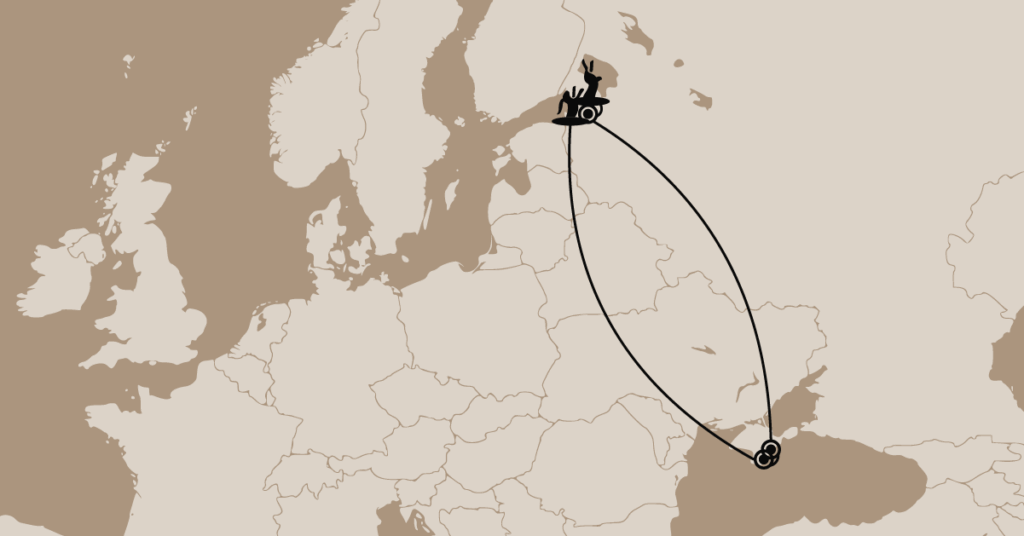
The Trip
This journey is more than a tour, it’s a passage through time, memory, and the turning of the seasons. Over the course of two to three weeks, you’ll trace the footsteps of the Romanovs, beginning in the snow-covered stillness of winter at the Winter Palace in St. Petersburg, where candlelight once flickered against frost-glazed windows. From there, spring awakens gently at the Alexander Palace in Pushkin, where lilacs bloom and family life once unfolded behind quiet walls. The summer sun then leads you to Crimea, to the warm, sea-laced breezes of Livadia and Massandra, where marble terraces overlook the Black Sea. Finally, the journey closes in the gilded hush of autumn at Peterhof, where leaves fall through the mist of fountains and the past feels as near as breath. With thoughtful planning, flights, transfers, and lodging fall easily into place, but the true gift is the way each setting, each season, pulls you deeper into the beauty and melancholy of a lost empire.
Winter
Winter Palace – St. Petersburg
Your imperial journey begins in the heart of St. Petersburg, where snow falls like powdered sugar on onion domes and frozen canals. The Winter Palace, now part of the Hermitage Museum, was the official residence of the Romanovs from the 1730s until the revolution in 1917. It’s a staggering introduction to the grandeur of the dynasty: 1,500 rooms, over 3 million works of art, and the weight of history in every gilded hall. Nicholas II lived here before moving to Alexander Palace, and it was from here that the Provisional Government was arrested during the October Revolution.
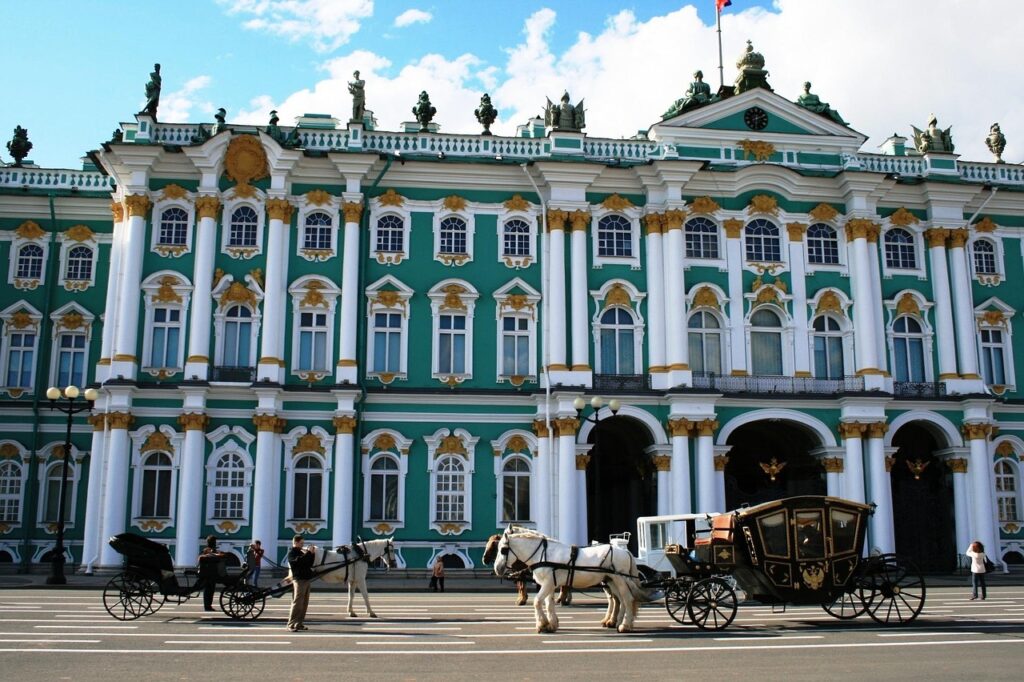
Image by Lynn Greyling from Pixabay
Fly into Pulkovo Airport (LED), where you will be greeted by a rush of cold air and the glow of city lights on the horizon. From the airport, it is about a 45-minute drive to the city center by taxi or shuttle. Spend three nights in St. Petersburg, which allows enough time to get lost in the halls of the Hermitage, wander the quieter corridors of the nearby Yusupov Palace, and savor hearty Russian dishes like steaming bowls of borscht or plates of pelmeni in a warm, wood-paneled restaurant. This city rewards those who take it slow. The history is heavy, yes, but it is also alive, flickering in shop windows, echoing in underground stations, and lingering in the white breath of people crossing bridges over frozen water.
Accommodations range from around one hundred dollars per night for charming local hotels with river views to about two hundred fifty for more luxurious stays with central locations and rich history. Wherever you stay, choose a spot that lets you walk the lively streets and watch the light shimmer on the domes at dusk.
Spend a full day exploring the Hermitage Museum but be sure to book timed tickets in advance to avoid the crowds. Take a nighttime canal tour if the rivers are clear, when St. Petersburg glows like a city suspended in a dream. Climb to the colonnade of St. Isaac’s Cathedral for panoramic views across the rooftops, domes, and distant spires. While you’re walking the same streets the Romanovs knew, remember that they spent their winters here, behind the frosted windows of the Winter Palace, as snow blanketed the city in silence. Even outside of the holiday season, the spirit of winter lingers in the golden-lit squares and hushed grandeur of the imperial capital.
Spring
Alexander Palace – Pushkin
Spring in Pushkin carries with it a quiet resurrection. The snow begins to melt, and in its place come blooms of white and purple lilacs that scent the imperial air. This is where the Romanovs came to feel human again. At the Alexander Palace in Tsarskoye Selo—now the town of Pushkin—life was softer, the pace gentler, and the days marked more by strolls in the garden than by affairs of state. Nicholas II, the last tsar, loved this place deeply; it was here that he lived with his family before the storm of revolution swept them away.
The Alexander Palace stands modest beside the grandeur of the nearby Catherine Palace, but its history is richer with intimacy and sorrow. This was not just a summer retreat—it was a home. Its pale yellow façade and quiet halls held the laughter of children, the pensiveness of a worried monarch, and the last moments of a world soon to vanish.
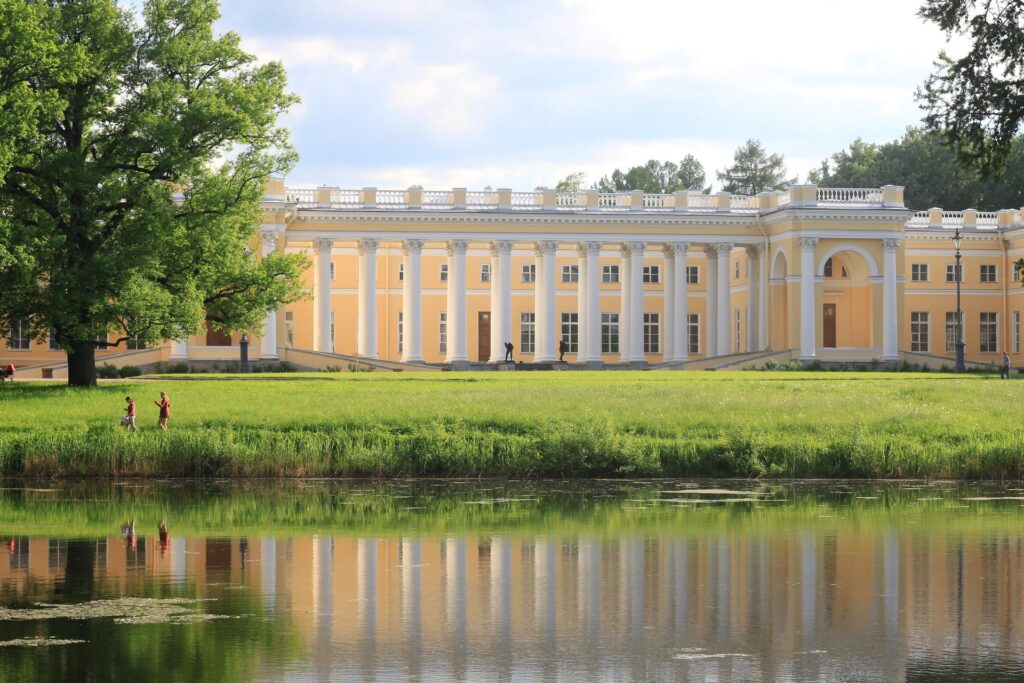
Take a taxi or train ride to Pushkin. Plan to stay two nights in this elegant town, where the streets still whisper of carriages and candlelight. Accommodations range from charming inns to boutique hotels, generally priced between $100 and $200 a night. Dine in restaurants offering dishes like beef stroganoff, herbed potatoes, and delicate blini with red currants.
Spend your first morning at the Alexander Palace, which has been carefully restored to its pre-revolutionary state. Walk the same corridors where Nicholas and Alexandra held their children close, and step into rooms filled with original furniture and personal effects. In the afternoon, visit the Catherine Palace with its dazzling Amber Room, a place of pure imperial spectacle.
Take time to wander through the vast parklands that surround both palaces: mirror-still lakes, white birch groves, and classical pavilions that seem to drift out from the trees like half-remembered dreams. Pushkin is a place where the past feels close, where footsteps echo through shaded alleys and the hush of history settles softly over every stone. The Alexander Palace offers a quieter, more intimate glimpse into Romanov life—its simplicity made all the more poignant by what would come after.
Summer
Livadia Palace & Massandra Palace – Crimea
Summer in Crimea is a lush and golden affair. The Black Sea glimmers beneath the sun, olive trees ripple in the breeze, and the salt air carries stories of tsars and treaties. For the Romanovs, this was their southern refuge—a place where formality melted away like ice in the garden sun. Livadia Palace, nestled in the hills above Yalta, became their favorite summer residence, a place where the Imperial family sought rest, privacy, and a semblance of normal life.
Livadia is a white limestone dream, with arched colonnades, sun-drenched balconies, and cypress-lined paths that overlook the sea. This was the palace where Nicholas II walked with his children, wrote in his diary, and let his guard down. After the revolution, it became the site of the 1945 Yalta Conference, adding a heavy political shadow to its once-peaceful elegance. Today, it remains beautifully preserved, with rooms staged as they were in the Romanov era, from the Empress’s boudoir to the Tsar’s study.
Just a short drive away is Massandra Palace, a whimsical neo-Gothic creation perched like a fairy-tale castle amid mountain pines. Though less visited than Livadia, Massandra offers a more eclectic glimpse into royal life, filled with quirky architecture and a lavish interior that reflects the tastes of Alexander III. Its terraced gardens and mountaintop views make for an enchanting afternoon escape.
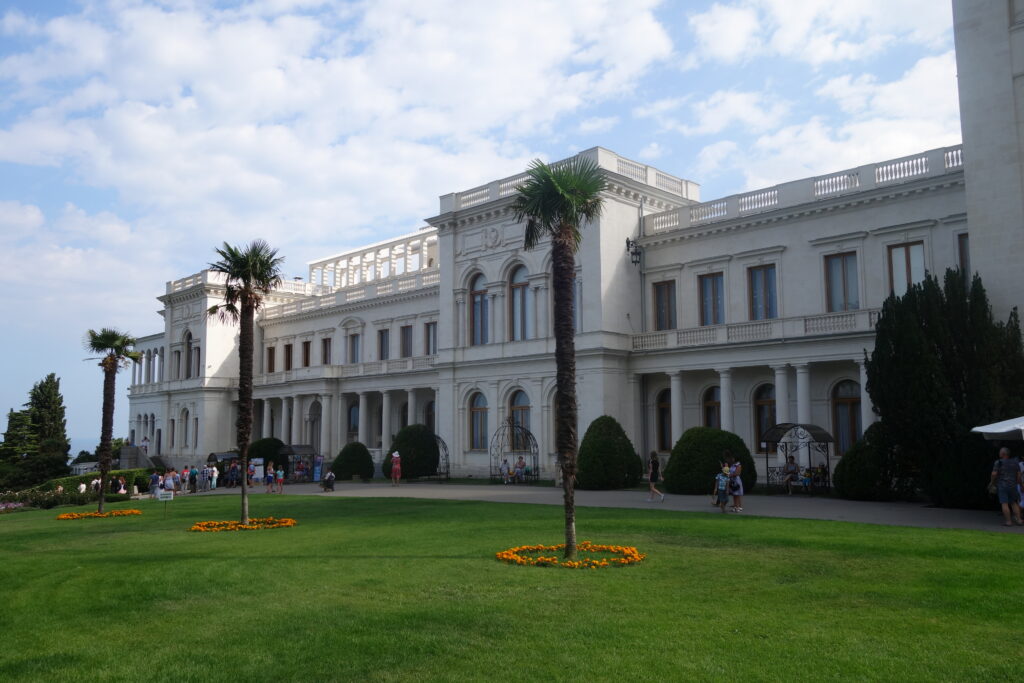
“Livadia Palace” by SunTW licensed under CC BY-SA 4.0. [Link]
Fly from St. Petersburg to Simferopol, then take a car or transfer (about 2 hours) down to Yalta. Spend three nights on the southern coast to soak in the warm air and explore both palaces at your leisure. Accommodations range from historic seaside resorts to modern boutique hotels, typically between $120 and $250 per night. Be sure to try the local Tatar cuisine: chebureki, lamb shashlik, and fresh peaches sold by the roadside.
Spend your mornings wandering through the marble halls and gardens of Livadia, then take afternoons to visit the Massandra vineyards or stroll along Yalta’s seaside promenade. Crimea in summer was where the Romanovs could breathe; and for the traveler, it still feels like a corner of Russia untouched by time.
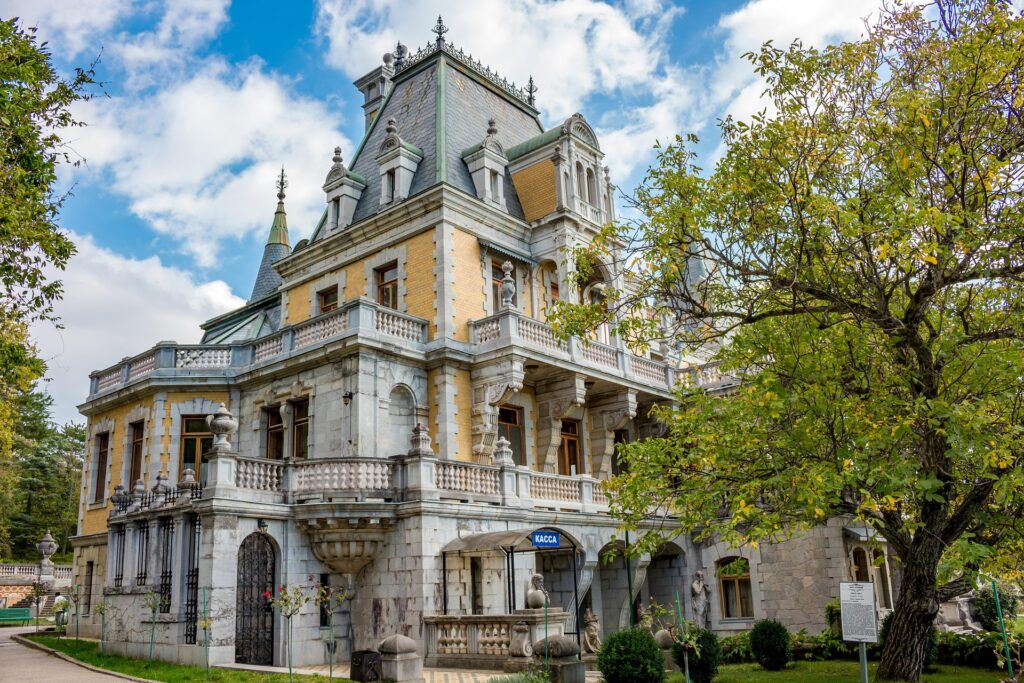
Autumn
Peterhof Palace – St. Petersburg
Autumn in imperial Russia was a season of reflection, and nowhere captured its golden melancholy like Peterhof. Sometimes called the “Russian Versailles,” Peterhof was the Romanovs’ grand statement to the world: a palace of fountains and flame, where golden statues glistened even under gray skies and water danced through gardens dressed in amber and rust. Commissioned by Peter the Great and expanded by his successors, the estate was a celebration of imperial ambition. For the Romanovs, Peterhof was a place to walk slowly, host intimate gatherings, and watch the season change with quiet grandeur.
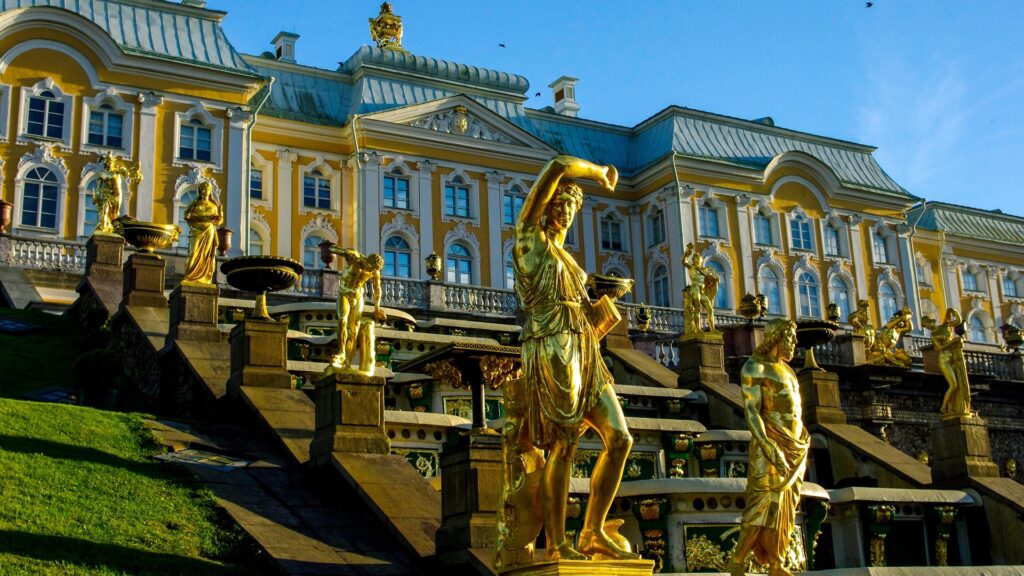
Image by Ramon Perucho from Pixabay
We end our trip by flying back to St. Petersburg and taking a jaunty boat ride across the gulf. Reach Peterhof by hydrofoil from central St. Petersburg, gliding across the Gulf of Finland in under an hour, or take a train or car for a more leisurely journey. Spend two nights here and stay in nearby hotels or guesthouses in Peterhof or return to the city each night (it’s close enough for day trips but tranquil enough to stay.)
Begin your visit with the Grand Palace, where the opulence of the Russian court still lingers in every ceiling fresco and parquet floor. Then, explore the Lower Gardens, a fantasyland of symmetry and surprise. Marvel at the Grand Cascade, a masterpiece of engineering and artistry, and search for the trick fountains hidden throughout the grounds as it was originally designed to delight and drench unsuspecting guests.
Dine at a cozy café within the park or enjoy a rustic Russian meal nearby. Think mushroom soup, baked buckwheat, and a warming glass of medovukha. As the sun dips lower and the sea breeze turns crisp, walk the coastal promenade lined with falling leaves and fading blooms. In autumn, Peterhof becomes not just a monument to monarchy, but a place where the past exhales its last breath of splendor before the stillness of winter
To follow the Romanovs through the seasons is to step into more than time; it is to walk through layers of memory, splendor, and silence. Winter begins in the glittering halls of the Winter Palace in St. Petersburg, where frost once traced the windows and the Neva lay still beneath its ice. From there, the path leads to the quiet grace of Pushkin, to the sun-soaked hills and sea breezes of Crimea, and finally to the golden hush of autumn in Peterhof. This journey is not simply a vacation: it is an act of remembering. You are moving through a vanished world that left its shadow on marble staircases and in quiet palace gardens. In retracing their footsteps, you may find more than history. You may find that the ghosts of empire are not always cold but they are sometimes warm with longing, light with laughter, and still alive in the wind that moves through the trees.